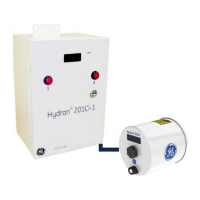• PowerStat. ID (identification number of the power station): All H201Ti’s in the
local network (power station) must be set to the same PowerStat. ID value.
This number can vary from 1 to 9999.
3. To continue the installation using a host computer, run either the Hydran Host
software (if 201Ti is set to Hydran protocol) or Perception software (if Hydran
201Ti is set to Modbus protocol) to define a local network using these
identification numbers. See the Hydran Host Software Manual or Perception User
Manual.
7.4.11 Verifying and Setting the Operation Mode of the Alarm Relays
For details on the parameters and commands in the submenu Relays/Analog, see
Section 5.5.7. For details on relays, see Section 11.2.
1. Access the submenu H201Ti Vx.xx; Relays/Analog.
2. Verify and set, as required, the three RelayMode parameters.
7.4.12 Verifying and Setting the Fail Alarm Conditions
1. Access the submenu SysOK Relay; FaultTrig.
2. Verify and set, as required, the 16 trigger conditions of the Hydran 201Ti’s fail
alarm relay.
Note: An asterisk at the end of the display’s bottom line indicates that the parameter is
turned on (the fail alarm is triggered if this condition is detected). A space indicates that
the parameter is off.
7.4.13 Verifying and Setting the Operation Mode of the Analog Output
and TDM Signal
1. Access the submenu H201Ti Vx.xx; Relays/Analog.
2. Verify and set, as required, the parameters AnalogMode and TDM Mode.
7.4.14 Conclusion
If the configuration has been performed using a host computer connected to the USB
connector located at the back of the CPU module, proceed as follows:
1. Access the submenu Communication.
2. Set the parameter CommChannel (communication channel) to Supervisory Link
(for Hydran protocol) or SuprvLink MODBUS (for Modbus protocol).
3. Press END to return to the Main Display mode.
The Hydran 201Ti configuration is now completed.

